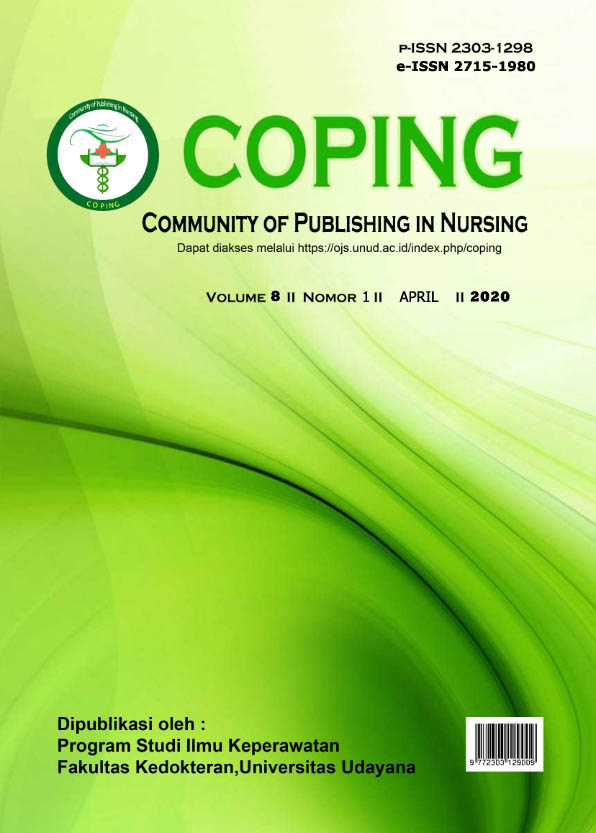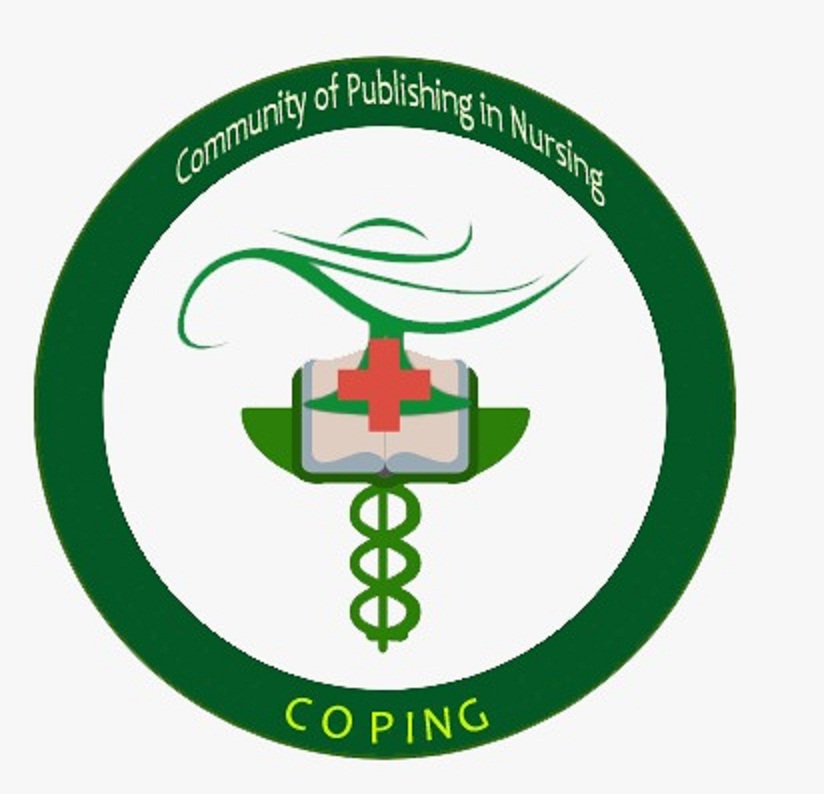Gambaran Tingkat Ansietas, Stres, dan Depresi pada Pengungsi Gunung Agung Pasca Mengungsi
Abstrak
Desa Sibetan merupakan desa yang paling banyak dipilih sebagai tempat pengungsian di Kabupaten Karangasem. Kondisi tempat pengungsian yang padat menyebabkan pengungsi rentan mengalami gangguan fisik dan psikologis. Ansietas, stress, dan depresi merupakan gangguan psikologis yang ditemukan pada penelitian sebelumnya. Penelitian ini bertujuan untuk mengetahui gambaran ansietas, stress, dan depresi pada pengungsi Gunung Agung pasca mengungsi di Desa Sibetan dengan menggunakan metode deskriptif dan pendekatan retrospective (tujuh bulan sejak peningkatan status pertama kali terjadi). Sampel diperoleh menggunakan teknik purposive sampling dengan jumlah 137 orang. Hasil penelitian yaitu mayoritas responden berumur 31-59 tahun, berjenis kelamin laki-laki, memiliki tingkat pengetahuan lulus SD, serta bekerja sebagai wiraswasta/ petani/ peternak. Sebanyak 14,60% responden mengalami ansietas; 10,95% responden mengalami stress; serta 13,87% responden mengalami depresi. Ansietas paling banyak dan berat terjadi pada kelompok umur 31-59 tahun, responden perempuan, tingkat pendidikan lulus SD, dan pekerjaan sebagai wiraswasta/ petani/ peternak. Sedangkan stress dan depresi paling banyak dan berat terjadi pada kelompok umur 31-59 tahun, tingkat pendidikan lulus SD, pekerjaan sebagai wiraswasta/ petani/ peternak, dan paling berat terjadi pada responden perempuan. Simpulan dalam penelitian ini yaitu masyarakat masih mengalami ansietas, stress, dan depresi walaupun sudah tujuh bulan sejak peningkatan status terjadi. Disarankan untuk mengkaji kondisi psikologis masyarakat secara berkelanjutan pada penelitian selanjutnya.
Kata kunci: ansietas, depresi, erupsi gunung agung, pasca mengungsi, pengungsi, stres
ABSTRACT
Sibetan Village is the most selected place to become shelter in Karangasem Regency. Crowd in shelter’s environment causes refugees to suffer physical and psychological problems. Anxiety, stress, and depression are found in the other researches. The aim of this research is to know the characteristic of anxiety, stress, and depression on Mount Agung’s refugee post evacuated at Sibetan Village with descriptive method and retrospective (seven month since the first raised status) approach. The samples were 137 which obtained by purposive sampling technique. The result of this research is most of respondents are 31-59 years old, male, passed elementary school, and worked as entrepreneur / farmer/ cattleman. 14.60% respondents suffer anxiety, 10.95% respondents suffer stress, and 13.87% respondents suffer depression. Anxiety mostly occur and severest in the age 31-59 years, female, passed elementary school, and worked as entrepreneur/ farmer/ cattleman. Meanwhile, stress and depression are mostly occur and severest in the age 31-59 years, passed elementary school, worked as entrepreneur/ farmer/ cattleman, and severest on female. This research conclude that people still suffer anxiety, stress, and depression even the raised status was seven month ago. Future research about people’s psychological condition should be done continuously.
Keywords: anxiety, depression, mount agung’s eruption, post evacuated, refugee, stress
##plugins.generic.usageStats.downloads##
Referensi
American Psychological Association. (2018). Beck Depression Inventory (BDI). Received from: http://www.apa.org/pi/about/publications/caregivers/practice-settings/assessment/tools/beck-depression.aspx
Avin, R. (2016). Ini 6 Negara Paling Berpotensi Terjadi Bencana Alam. Received from: https://media.iyaa.com/article/2016/04/Ini-6-Negara-Paling-Berpotensi-Terjadi-Bencana-Alam-3439808.html diakses pada 25 September 2017
Badan Nasional Penanggulangan Bencana. (2014). Indeks Risiko Bencana Indonesia 2013. Jawa Barat: Badan Nasional Penanggulangan Bencana
Bonanno, G. A., Brewin, C. R., Kaniasty, K., & Greca A. M. L. (2010). Weighing the Costs of Disaster: Consequences, Risks, and Resilience in Individuals, Families, and Communities. Psychological Science in the Public Interest. Vol 11 (1): 1-49
Cohidon, C., Diene, E., Carton, M., Fatras, J. Y., Goldberg, M., & Imbernon, E. (2009). Mental Health of Workers in Youlouse Two Years after the Industrial Azf Disaster: First Results of a Longitudinal Follow-Up of 3,000 People. Social Psychiatry and Psychiatric Epidemiology. Vol 44: 784–791
Dai, W., Kaminga, A. C., Tan, H., Wang, J., Lai, Z., Wu, X. . . Liu, A. (2017). Long-Term Psychological Outcomes of Flood Survivors of Hard-Hit Areas of the 1998 Dongting Lake Flood in China: Prevalence and Risk Factors. PlosOne. Vol 12(2): 1-14
Deribew, A., Tesfaye, M., Hailmichael, Y., Apers, L., Abebe, G., Duchateau, L. Colebunders, R. (2010). Common Mental Disorders in TB/HIV Co-Infected Patients in Ethiopia. BMC Infectious Diseases. Vol 10: 201-209
Fatoni, Z. (2015). Dampak Bencana Terhadap Masalah Kesehatan. Jakarta: Pusat Penelitian Kependudukan
Feyera, Mihretie, Bedaso, Gedle, & Kumera. (2015). Prevalence of Depression and Associated Factor among Somali Refugee at Melkadida Camp, Southeast Ethiopia: A Cross-Sectional Study. BMC Psychiatry. Vol 15: 171-178
Foa, E. B., Stein, D. J., & McFarlane, A. C. (2006). Symptomatology and Psychopathology of Mental Health Problems after Disaster. Journal of Clinical Psychiatry. Vol 67 (2): 15-25
Gamar, R. (2017). Status Gunung Agung Diturunkan dari Awas ke Siaga. Denpasar: Kompas
Hailemariam, S., Tessema, F., Asefa, M., Tadesse, H., & Tenkolu, G. (2012). The Prevalence of Depression and Associated Factors in Ethiopia: Findings from the National Health Survey. Internatiional Journal of Mental Health System. Vol 6: 23-34
Havard Health Publishing. (2018). Anxiety and Physical Illness. Boston: Havard Medical School
Humas Satgas Tanggap Darurat Bencana Erupsi Gunung Agung. (2017). Wawancara, 8 November 2017
Ikeda, A., Tanigawa, T., Charvat, H., Wada, H., & Shigemura, J. (2017). Longitudinal Effects of Disaster-Related Experiences on Mental Health among Fukushima Nuclear Plant Workers: The Fukushima NEWS Project Study. Psychological Medicine. Vol 47 (11): 1936-1946
Imani, S., Torki, Y., Zamani, R., & Ebrahimi, S. M. (2014). Elder’s General Self-Efficacy and Its Affectiong Factors in Iran. Iranian Journal of Public Health. Vol 43(8): 1163-1164
Kar, N. & Bastia, B. K. (2006). Post-Traumatic Stress Disorder, Depression and Generalised Anxiety Disorder in Adolescents after a Natural Disaster: A Study of Comorbidity. Clinical Practice and Epidemiology in Mental Health. Vol 2: 17-24
Kukihara, H., Yamawaki, N., Uchiyma, K., Arai, S., & Horikawa, E. (2014). Trauma, Depression, and Resilience of Earthquake/ Tsunami/ Nuclear Disaster Survivors of Hirono, Fukushima, Japan. Psychiatry and Clinical Neurosciences. Vol 68: 524–533
Liu A., Tan, H., Zhou, J., Li, S., Yang, T., Wang, J., . . . Wen, S. W. (2006). An Epidemiologic Study of Posttraumatic Stress Disorder in Flood Victims in Hunan China. Canadian Journal of Psychiatry. Vol 51(6): 350-354
Livana, P. H., Daulima, N. H. C., & Mustikasari, M. (2020). Karakteristik Keluarga Pasien Gangguan Jiwa yang Mengalami Stres. Jurnal Ners Widya Husada Semarang, 4(1), 27-34.
Livana, P. H., & Wardani, I. Y. (2020). Karakteristik Keluarga Pasien Hemodialisis yang Mengalami Stres. Jurnal Ners Widya Husada Semarang, 6(3), 73-78.
Mental Health. (2018). Smoking and Mental Health. England: Mental Health Organization
Nakayachi, K. & Nagaya, K. (2016). The Effects of the passage of Time from the 2011 Tohoku Earthquake on the Public’s Anxiety about a Variety of Hazards. International Journal of Environmental Research and Public Health. Vol 13: 866 - 878
Paranjothy, S., Gallacher, J., Amlot, R., Rubin, G. J., Page, L., & Baxter, T. (2011). Psychosocial Impact of the Summer 2007 Floods in England. BMC Public Health. Vol 11: 145
Sabin, M., Cardozo, B. L., Nackerud, L., Kaiser, R., Varese, L. (2003). Factors Associated with Poor Mental Health among Guatemal Refugees Living in Mexico 20 Years after Civil Conflict. JAMA. Vol 290 (5): 635-642
Saut, P. D. (2017). Status Gunung Agung Naik Jadi Awas, Warga Langsung Mengungsi. Surabaya: DetikNews
Shokri, S. & Akbari, B. (2016). The Relationship of Self-efficacy with Life Expectancy and Death Anxiety in Elders over 60 years old of Resident in Nursing Homes of Rasht City. Electronic Journal of Biology. Vol 12(3)
Steven, G. J., Dunsmore, J. C., Agho, K. E., Taylor, M. R., Jones, A. L., Ritten, J. J., . . . Raphael, B. (2013). Long Term Health and Wellbeing of People Affected by the 2002 Bali Bombing. MJA. Vol 198: 273-277
Tang, W., Zhao, J., Lu, Y., Yan, T., Wang, L., Zhang, J., . . . Xu, J. (2017). Mental Health Problems among Chldren and Adolescents Experiencing Two Major Earthquakes in Remote Mountainous Region: A Longitudinal Study. Cmoprehensive Psychiatry. Vol 72: 66-73
Tanisho, Y., Shigemura, J., Kubota, K., Tanigawa, T., & Bromet, E. J. (2016). The Longitudinal Mental Health Impact of Fukushima Nuclear Disaster Exposures and Public Criticism among Power Plant Workers: the Fukushima NEWS Project Study. Psychological Medicine. Vol 46 (15): 3117-3125
Telles, S., Singh, N., & Joshi, M. (2009). Risk of Posttraumatic Stress Disorder and Depression in Survivors of the Floods in Bihar, India. Canadian Indian Journal of Medical Science. Vol 63(8): 330-334
Thompson, D. J., Weissbecker, I., Cash, E., Simpson, D., M., Daup, M., & Sephton, S. E. (2015). Stress and Cortisol in Disaster Evacuees: An Exploratory Study on Associations with Social Protective Factors. Psychophysiol Biofeedback. Vol 40: 33-44
Tsujiuchi, T., Yamaguchi, M., Masuda, K., Tsuchida, M., Inomata, T., Kumano, H., . . . Mollica, R., F. (2016). High Prevalence of Post-Traumatic Stress Symtomps in Relation to Social Factors in Affected Population One Year after the Fukushima Nuclear Disaster. Plos ONE. Vol 11(3): 1-14
Vonnahme, L. A., Lankau, E. W., Ao, T., Shetty, S., & Cardozo, B. L. (2014). Factors Associated with Symptoms of Depression among Bhutanese Refugees in the United States. Journal of Immigrant Minority Health. Vol 17: 1705-1714
Yudhoyono, S. B. (2012). Bali Bombing Created Unity, Stronger Relations. Sydney: The Sydney Morning Herald
Zimmerman, E. B., Woolf, S. H., & Haley, A. (2015). Population Health: Behavioral and Science Insights. Rockville: Agency for Healthcare Research and Quality.








